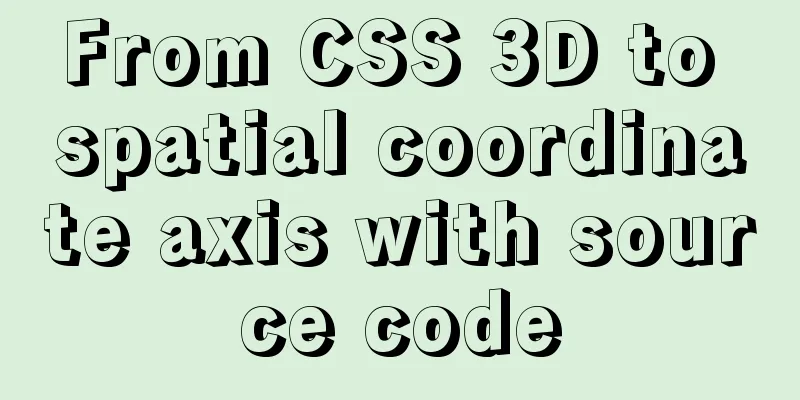From CSS 3D to spatial coordinate axis with source code

|
One time we talked about the dice rolling game. At that time, we used a steps attribute + sprite image to make frame animation. This is of course quite good, but in fact, this is not what I thought at the beginning. I wanted to use real 3D and animation to do it. This plan involves a lot of spatial knowledge. Today I will tell you how to play this CSS 3D. First, the effect picture:
Basic idea: three-layer structure: perspective container >> carrier >> specific 3D image. Perspective container: determines the 3D rendering effect. The perspective attribute here receives parameters in pixels. The larger the perspective value, the farther the eyes are from the object being observed, and the smaller the value, the closer the eyes are to the object being observed. Without the perspective attribute, the viewing angle cannot be adjusted.
Carrier: Supports 3D images The biggest difference between this vector and ordinary HTML tags is that it has an additional attribute: transform-style:preserve-3d. Indicates that it supports 3D image display. If this attribute is missing, the 3D graphics that have undergone 3D conversion will be compressed into a 2D plane and will not be able to present a 3D effect, because the container is flat, even if the content is 3D. Concrete 3D images: conversion from 2D to 3D The 3D images here are all converted from 2D plane images, so how to convert them? You need to use the translateX, translateY, translateZ attributes, of course the abbreviation is translate-3d, and rotateX, rotateY, rotateZ and so on. The specific rules of translate and rotate are based on the famous reference picture below: three-dimensional coordinate diagram.
First, let's talk about the rules of translate. There is no need to explain this in detail. Just refer to it. For example, translateZ(-100px) in this picture is equivalent to moving the image 100px in the direction of the -z axis. A more vivid way of saying it is "sunken 100px into the screen." translateX, translateY and so on. The difficulty lies in rotate. Let me tell you a very simple rule of judgment: if the positive axis is facing the eyes, the clockwise rotation angle is positive, and the counterclockwise rotation angle is negative. It's that simple. For example, if we want to make a 3D dice, first, the six planes are placed in the center of the three-dimensional coordinate system as shown in the figure above. Their sizes are the same as the carrier. To turn them into a dice, the following transformations need to be done: (Note: The length and width of the carrier and the six faces are both 200px)
Just refer to the 3D picture and make some gestures and you will know what is going on. Attach all source code:
<template>
<div class="box">
<section class="cube">
<div class="front">Front</div>
<div class="back">Back</div>
<div class="left">Left</div>
<div class="right">Right</div>
<div class="top">Above</div>
<div class="bottom">Below</div>
</section>
</div>
</template>
<style lang="less" scoped>
.box {
width: 100%;
height: 100%;
perspective: 500px;
}
.cube {
position: relative;
width: 200px;
height: 200px;
margin: 100px auto;
color: #ff92ff;
font-size: 36px;
font-weight: 100;
text-align: center;
line-height: 200px;
transform-style: preserve-3d;
transform: rotateX(-50deg) rotateY(-50deg) rotateZ(0deg);
// animation: move 8s infinite linear;
@keyframes move {
0% {
transform: rotateX(0deg) rotateY(0deg) rotateZ(0deg);
}
100% {
transform: rotateX(720deg) rotateY(360deg) rotateZ(360deg);
}
}
div {
position: absolute;
width: 100%;
height: 100%;
border: 10px solid #66daff;
border-radius: 20px;
background-color: rgba(51, 51, 51, 0.3);
}
.front {
transform: translateZ(100px);
}
.back {
transform: translateZ(-100px) rotateY(180deg);
}
.left {
transform: translateX(-100px) rotateY(-90deg);
}
.right {
transform: translateX(100px)rotateY(90deg);
}
.top {
transform: translateY(-100px) rotateX(90deg);
}
.bottom {
transform: translateY(100px) rotateX(-90deg);
}
}
</style>Summarize The above is what I introduced to you from CSS 3D to spatial coordinate axes with source code. I hope it will be helpful to you. If you have any questions, please leave me a message and I will reply to you in time! |
<<: Deployment and Chinese translation of the docker visualization tool Portainer
>>: IE8 uses multi-compatibility mode to display web pages normally
Recommend
In-depth explanation of SQL statement execution (MySQL architecture overview -> query execution process -> SQL parsing order)
Preface: I have always wanted to know how a SQL s...
Detailed explanation of Nginx Location configuration (Location matching order)
Location means "positioning", which is ...
Multi-service image packaging operation of Dockerfile under supervisor
Writing a Dockerfile Configure yum source cd /tmp...
Detailed explanation of .bash_profile file in Linux system
Table of contents 1. Environment variable $PATH: ...
Comparison of several examples of insertion efficiency in Mysql
Preface Recently, due to work needs, I need to in...
The process of building a development environment based on visual studio code + react
Development environment windows Development Tools...
How to optimize MySQL indexes
1. How MySQL uses indexes Indexes are used to qui...
The difference and usage of single-line and double-line layout in Flex mobile layout
Here is a single-line layout using ul>li for l...
Detailed explanation of Vue routing router
Table of contents Using routing plugins in a modu...
Sample code for nginx to achieve dynamic and static separation
1. Simple configuration of nginx's dynamic an...
Detailed explanation of Angular component life cycle (I)
Table of contents Overview 1. Hook calling order ...
MySQL 5.7.17 installation and configuration method graphic tutorial (Ubuntu 16.04)
Download the latest version of MySQL for Ubuntu L...
Pure CSS to achieve the list pull-down effect in the page
You may often see the following effect: That’s ri...
CentOS7 enables MySQL8 master-slave backup and daily scheduled full backup (recommended)
Note 1: Solve the problem of slow connection to M...
View the number of files in each subfolder of a specified folder in Linux
count script #!/bin/sh numOfArgs=$# if [ $numOfAr...














